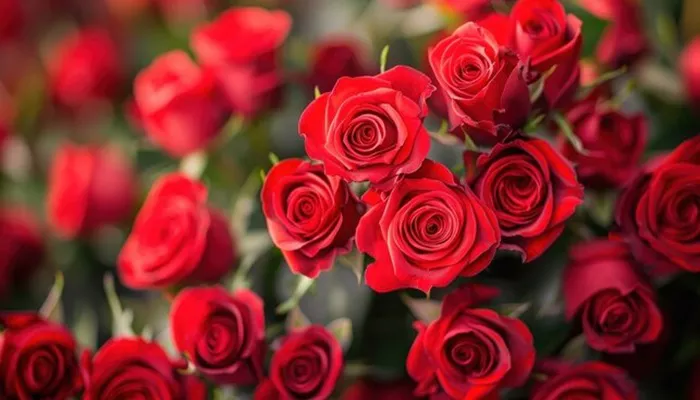Valentine’s Day is a time when flowers are exchanged as symbols of love and affection. Red roses, in particular, are a popular choice. But have you ever wondered just how dominant red flowers are in the floral purchases made on this special day? This article delves into the percentage of flowers bought on Valentine’s Day that are red, explores the reasons behind this preference, and provides a detailed overview of floral trends and their significance.
Introduction to Valentine’s Day Flower Trends
Valentine’s Day is celebrated globally on February 14th, and it is one of the biggest days for flower sales. Traditionally, flowers symbolize various emotions and messages, but none are as universally associated with love as the red rose. The popularity of red flowers on Valentine’s Day reflects a deeper cultural and emotional significance, intertwining tradition with modern preferences.
Historical Significance of Red Flowers
Cultural Roots of the Red Rose
The red rose has long been a symbol of love, dating back to ancient cultures. In Greek mythology, roses were linked to the goddess of love, Aphrodite, and her son, Eros. The red rose became a potent symbol of passionate love due to its vibrant color and strong fragrance, which made it a natural choice for expressing romantic feelings.
Evolution of Flower Preferences
Over the centuries, the meaning and significance of flowers have evolved. However, the red rose has maintained its status as a preferred choice for expressing love. This tradition has been reinforced through literature, art, and media, which continually promote the red rose as the ultimate symbol of romance.
Current Trends in Flower Purchases
Statistics on Flower Sales
Recent data shows that red flowers, particularly red roses, dominate the floral market on Valentine’s Day. According to industry reports, red roses account for approximately 60% to 70% of all flower sales on this day. This significant percentage highlights the enduring appeal of the red rose and its central role in Valentine’s Day celebrations.
Comparative Analysis
To understand this trend better, it’s useful to compare it with other popular flowers. While red roses lead in sales, other colors and types of flowers are also popular. For instance, pink roses, white lilies, and mixed floral arrangements make up the remaining 30% to 40% of sales. The choice of flowers can vary based on personal preferences, regional trends, and cultural influences.
Reasons Behind the Popularity of Red Flowers
Symbolism and Tradition
The symbolism associated with red flowers is a major factor driving their popularity. Red roses convey deep love and passion, making them an ideal choice for Valentine’s Day. This traditional symbolism resonates with many people, reinforcing the red rose’s dominance in floral arrangements.
Emotional Appeal
The vibrant red color of roses is associated with strong emotions and passion. This emotional appeal is a powerful motivator for individuals choosing flowers for their loved ones. The striking appearance of red roses makes them stand out, adding to their allure.
Marketing and Commercial Influence
Marketing strategies play a crucial role in the prominence of red flowers on Valentine’s Day. Florists and retailers often promote red roses heavily during the lead-up to February 14th, influencing consumer choices. Special deals, advertisements, and eye-catching displays further boost the appeal of red flowers.
Regional Variations and Preferences
Global Trends
While red roses are universally popular, regional preferences can vary. In some cultures, other flowers may be favored. For example, in some Asian countries, chrysanthemums and lilies are more common. Understanding these regional differences provides a broader perspective on floral trends.
Cultural Influences
Cultural factors also influence flower preferences. In countries with strong traditions surrounding Valentine’s Day, the red rose is likely to be the dominant choice. Conversely, in regions where different flowers hold significant cultural meaning, preferences may shift.
see also: How to Keep My Valentine Flowers Alive?
The Impact of Modern Trends
Eco-Friendly and Sustainable Choices
Recent trends show a growing interest in eco-friendly and sustainable floral options. This shift is influencing the types of flowers people buy, including alternatives to traditional red roses. Consumers are increasingly aware of the environmental impact of their choices and are exploring sustainable floral options.
Customization and Personalization
Personalized floral arrangements are gaining popularity. Many people now opt for custom bouquets that reflect their unique relationships and preferences. This trend includes a broader range of flowers and colors, potentially reducing the dominance of red roses in some cases.
Conclusion
In summary, red flowers, particularly red roses, dominate Valentine’s Day floral purchases, accounting for approximately 60% to 70% of sales. This preference is driven by deep cultural symbolism, emotional appeal, and effective marketing strategies. While other flowers and colors also hold significant appeal, red roses remain the quintessential symbol of love and passion on Valentine’s Day. Understanding these trends provides insight into both historical and contemporary floral preferences, highlighting the enduring significance of the red rose in expressing romantic sentiments.
As floral trends continue to evolve, with increasing attention to sustainability and personalization, the traditional dominance of red roses may face new challenges. However, their iconic status and powerful symbolism ensure that they will likely remain a central feature of Valentine’s Day celebrations for years to come.
Related topics:
- The Best Online Flowers for Valentine’s Day
- The Power of Flowers on Valentine’s Day
- What Color Flowers for Valentine’s Day?


